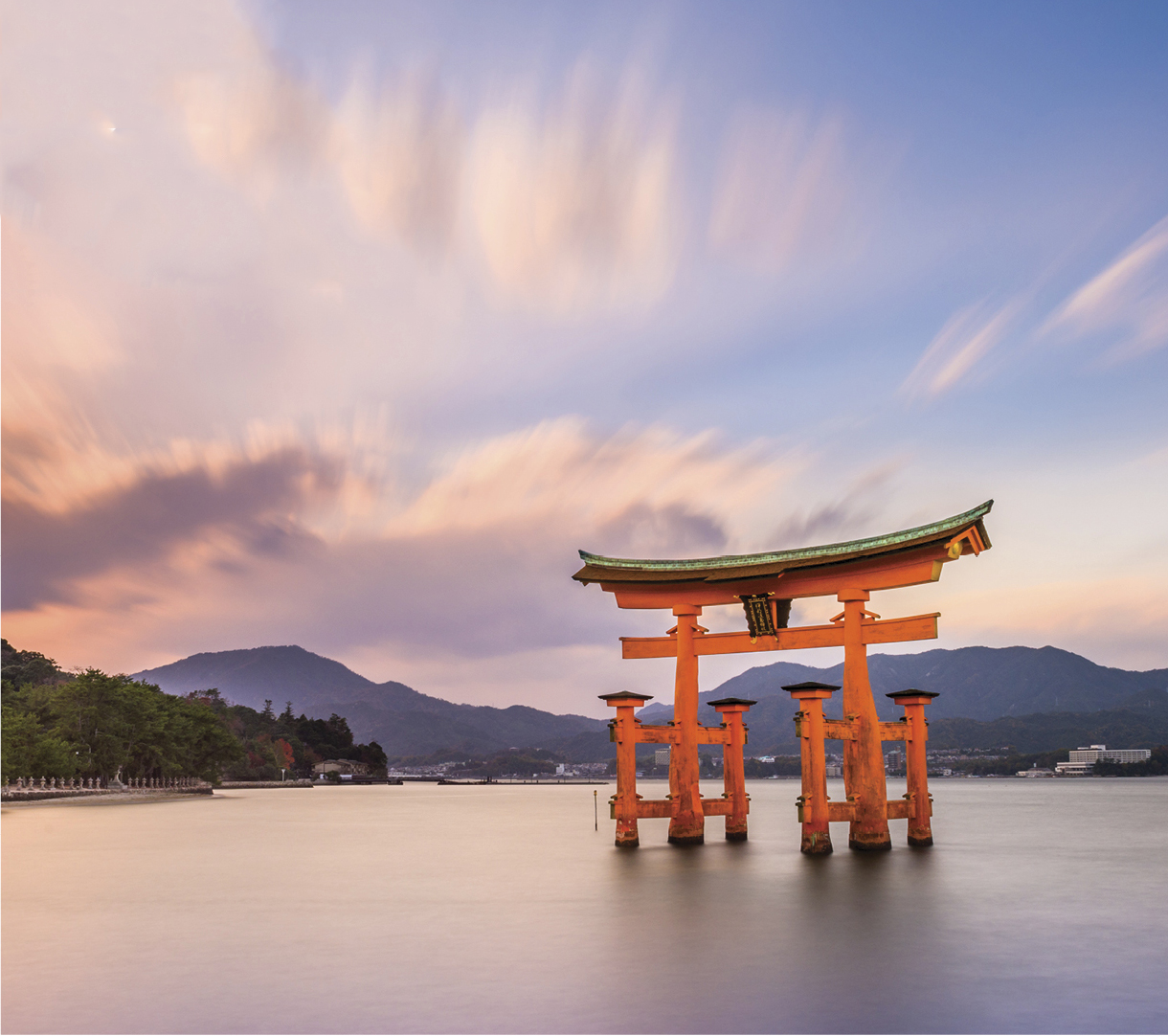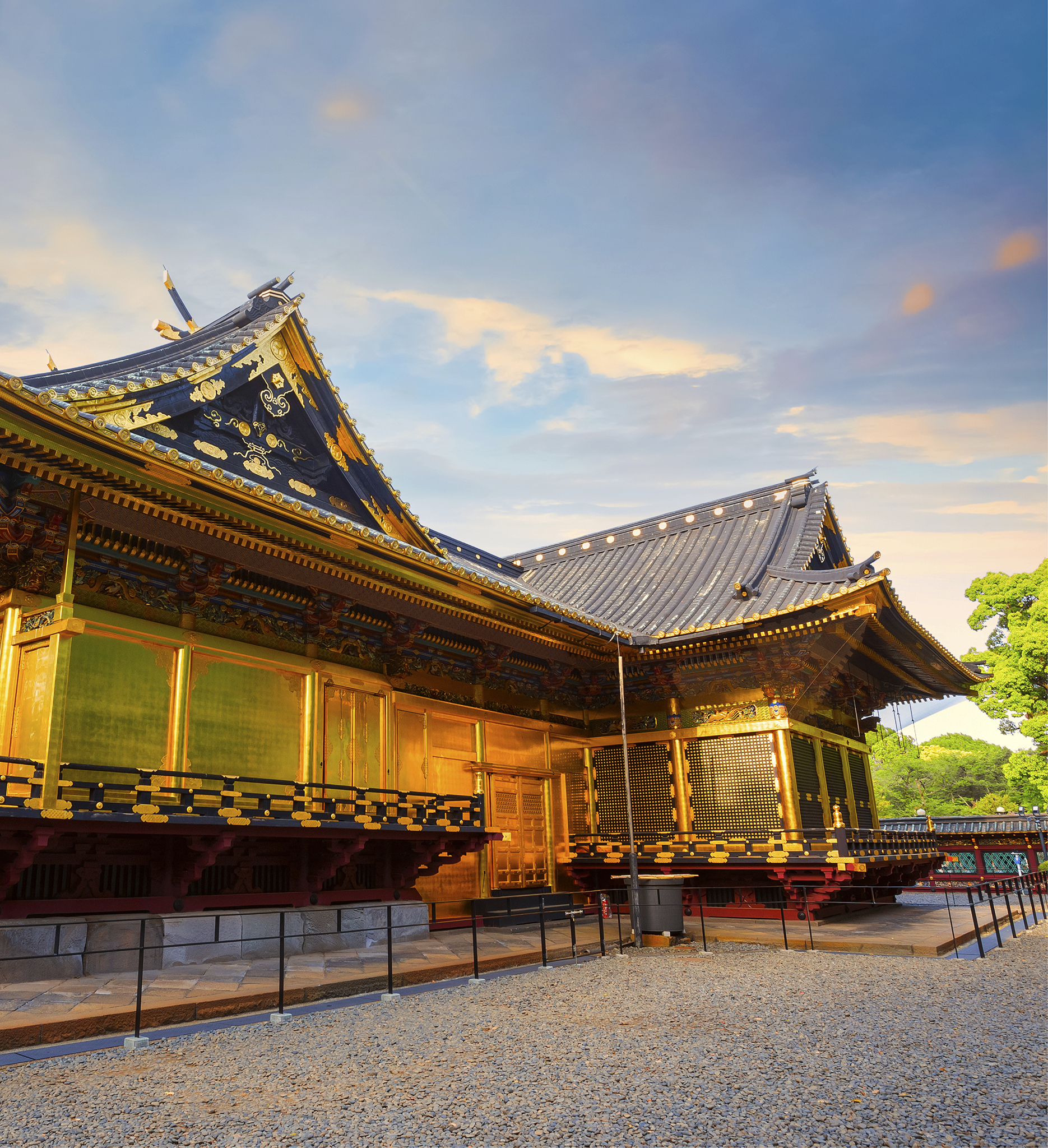神道
Shinto
Way of the gods
Japan’s oldest religion, Shinto (“way of the gods”) finds divinity in all aspects of nature. It has no founder or sacred scriptures; instead, its philosophy is centered around living life in harmony and cooperation with everything and everyone around you.
Be More Japan SHINTO

D The torii (gate) of Itsukushima Shrine (Miyajima Island) is one of Japan’s three most scenic views.

D The fox (kitsune) is a messenger of the kami Inari.
The core concept of Shinto is that deities known as kami preside over all things in nature, be they living, dead, or inanimate. There are lesser and greater kami, who exist in everything from rocks and trees to phenomena like the wind and waves and even illnesses. The kami reside at sacred shrines (jinja), where people go to worship them. Each shrine is devoted to a particular kami—Inari shrines such as Fushimi Inari-Taisha in Kyoto, for example, are dedicated to the god of prosperity (symbolized by rice) and safety, and are easily distinguishable by stone foxes on the grounds that serve as the deity’s messengers. Other popular kami include Hachiman, the deity of archery and war, whose shrines include the famous Tsurugaoka-Hachimangu in Kamakura.
Prayer and harmony
Purification ceremonies and other rituals are performed at set times throughout the year, but generally shrines are informal places that people visit at their leisure to make a prayer or offering. Shinto’s emphasis on harmony means that it is highly tolerant of other religions, and you may sometimes find Shinto shrines at Buddhist temples—many Japanese people will happily visit and perform rites at both.
Many facets of Japanese life, including an emphasis on cleanliness and an austere aesthetic, have their roots in Shinto practice. Shinto’s deep affinity with nature is also reflected in the concept of wabi-sabi, which sees beauty in natural imperfections.

D The honden is the most sacred building at a shrine; this one is at Ueno Toshogu in Tokyo.
Visiting a Shrine
Visiting one of Japan’s 80,000 shrines is like stepping into an oasis of intense calm, where the atmosphere thrums with an almost tangible connection to the natural and spiritual worlds. To reach this hallowed space you must first pass through a torii— a vermilion gateway that symbolizes the border between the ordinary and sacred realms. Most shrines just have one torii, but some, such as Kyoto’s Fushimi Inari-taisha, have tunnels made up of thousands of them. As you enter the complex, look out for the auspicious animal statues and shimenawa (decorative ropes of rice straw or hemp that hang over entrances), which protect the shrine from evil and sickness.
Before heading further inside the shrine, make your way to the stone water basin near the entrance to wash your hands (a sign of purification). From there, a stone sando (pathway) leads to the haiden (offering hall) and honden (sanctuary) where the shrine’s kami resides. Only the haiden is open to the general public; the honden is usually only entered by the head priests. Alert the kami to your presence by ringing a bell and clapping your hands before praying. It’s also traditional to toss a coin into the trough in front of the shrine —five and fifty yen (the coins with holes in them) are considered the most propitious.
like new
Japan’s ancient Shinto shrines often look brand new—this is because they are rebuilt as exact replicas every 20 years to repurify the ground.
Be More Japan SHINTO

D Left to right: The torii at Meiji Jingu is made from 1,500-year-old cypress pine from Taiwan; thousands of vermilion torii line the 2.5-mile- (4-km-) long trail to Fushimi Inari-taisha; the unique Meoto Iwa, or “wedded rocks,” at Futamigaura Beach symbolize the union of marriage.
wedded rocks
The wedded rocks of Futami represent the union of the central deities in the Shinto creation myth.
japan’s most sacred shrines
Nearly every community has a Shinto shrine, but the following hold a special place in the Shinto world.
Ise Jingu Japan’s most sacred Shinto shrine, in the seaside town of Ise (Mie Prefecture), is split into two compounds: the outer Geku and the more significant inner Naiku. Legend has it that a mirror representing the Sun Goddess Amaterasu, the ultimate ancestress of Japan’s current imperial family, rests in the Naiku.
Izumo Taisha Second in importance to Ise Jingu is Izumo Taisha in Izumo (Shimane Prefecture). It is dedicated to the God of Happy Marriage, Okuninushi-no-mikoto, which makes it popular with couples. It is also the location for the annual November gathering of the millions of kami from all over Japan, who are believed to meet to discuss the year’s events.
Atsuta Jingu Established around 1,900 years ago, Atsuta Jingu in Nagoya (Aichi Prefecture) was founded to house a legendary sword that is one of Japan’s Three Sacred Treasures.
Meiji Jingu Tokyo’s premier Shinto shrine is a memorial to Emperor Meiji and his empress Shoken. Built in 1920, it is a grand, austere affair surrounded by 120,000 trees of 365 different species. The 40-ft- (12-m-) tall torii is the largest in Japan.
Itsukushima Jinja On Miyajima Island (Hiroshima Prefecture), Itsukushima Jinja is one of Japan’s most recognizable shrines. Its low-slung halls, which rest on pierlike bases, and its striking vermilion torii rising out of the bay make it appear as if the shrine is floating on water.
Tosho-gu Breaking the austere mold of Shinto architecture is Tosho-gu in Nikko (Tochigi Prefecture), final resting place of the 17th-century shogun Ieyasu Tokugawa. Elaborately decorated with carving, gilting, and lacquering, its standout feature is the glittering Yomei-mon (Sun Blaze Gate).
Be More Japan SHINTO
The Three Sacred Treasures of japan
Legend has it that the Three Sacred Treasures of Japan—the mirror Yata no Kagami (housed at Ise Jingu, Ise); the jade jewel Yasakani no Magatama (Imperial Palace, Tokyo); and the sword Kusanagi (Atsuta Jingu, Nagoya)—were brought to earth by the deity Ninigi-no-Mikoto, ancestor of the Japanese imperial line. Few know for sure if they exist because they are never put on public display.
